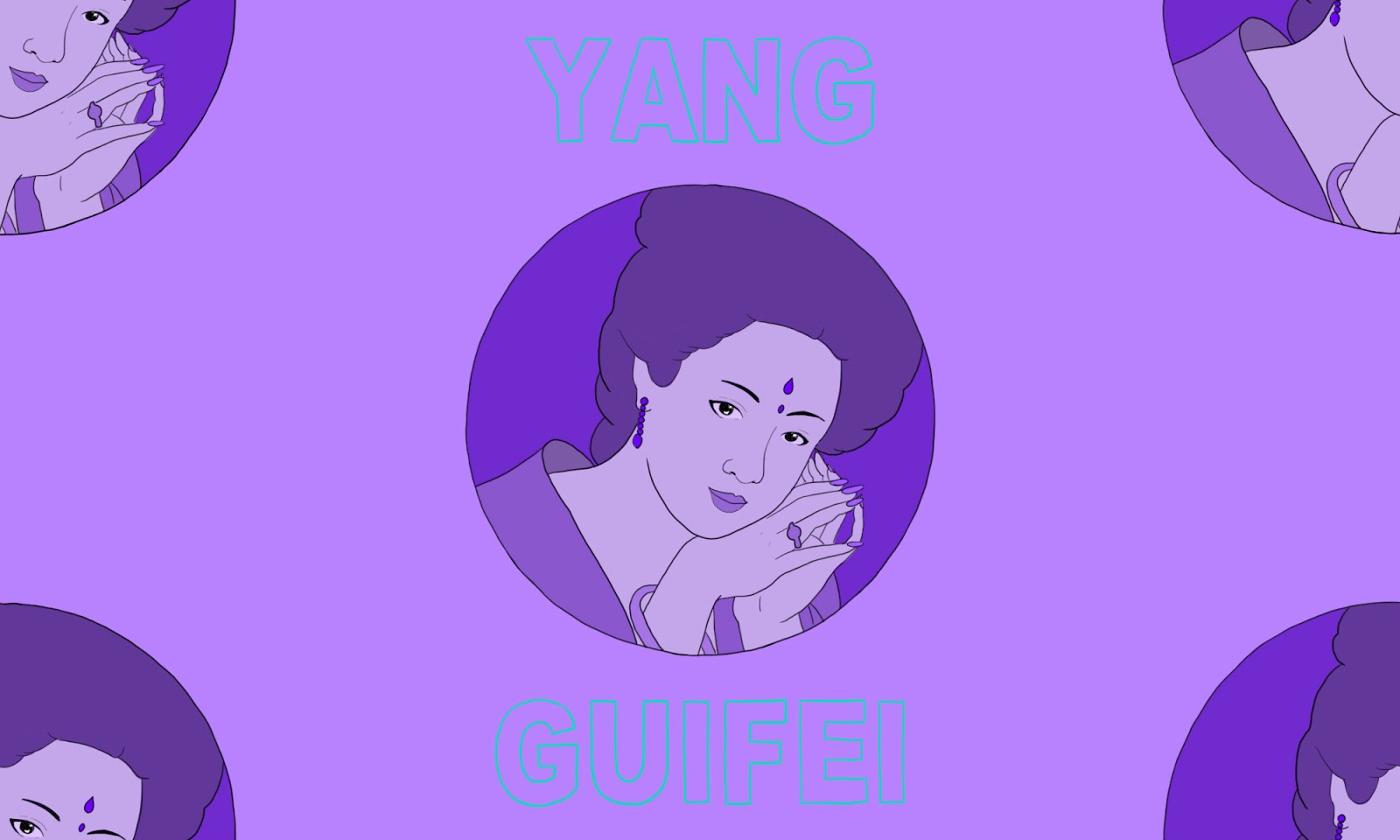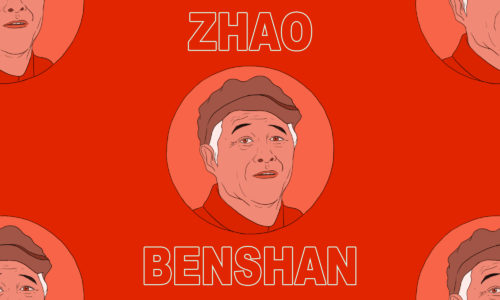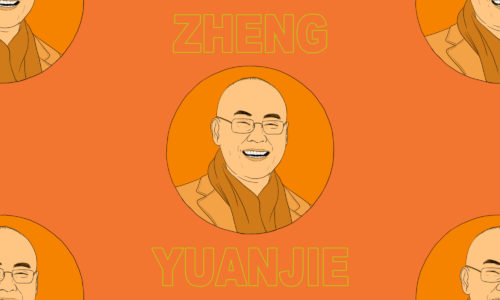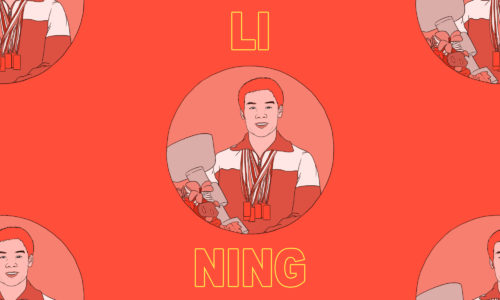In the 740s, Europe was in the Dark Ages, with nothing on the horizon except the Vikings. But on the other side of the Eurasian landmass, a beautiful woman lived in unimaginable splendor, crowned with a burnished gold-leaf tiara and enrobed in gossamer and gold brocade, courtesy of the 700 artisans who filled her wardrobe. She snacked on fresh lychees and feasted on purple camel-hump meat with rhino horn chopsticks, in a pepper-scented palace at the heart of a city of up to 2 million people.
Her name was Yáng Guìfēi 杨贵妃. She’s immortalized as one of the four beauties of Ancient China, and played a major part in the downfall of her world, the “Golden Age” of the legendary Tang Dynasty.
Her reception down the centuries has been mixed, a classic femme fatale with the beauty of Helen of Troy and the power plays of Cleopatra. She’s innocent and corrupt, powerful and powerless. For some, she’s a decadent diva who sowed the seeds of the Tang’s downfall. For others, she’s a figure of doomed love, with a tragic death known all over China.
Who is Yang Guifei?
Her real name was Yáng Yùhuán 杨玉环, born to a Sichuan official in charge of the census, in 719 AD.
We’ll never know for certain who she really was. The sources observe her, but don’t let her speak. It leads to a woman eternally objectified, with features and motives melded to fit the times — “who she was” seems to be based on current standards of beauty and the author’s stance on women in power. Our knowledge of her rise and fall come from official histories like the Old Book of Tang and New Book of Tang, but they’ve been heavily embellished by legend.
She first came to the attention of the great Emperor Xuanzong in 733, when she was presented as the bride of his son, Lǐ Mào 李瑁. For 20 years, Xuanzong had already proved a competent and diligent ruler, but this meeting marked the start of his decline into hedonism. Legend says he arranged for her to bathe in the hot springs at Huaqing Palace (normally reserved for the emperor, his family, and most senior officials). When he saw her emerging from the steamy pools, cheeks “moist and flushed” (as Yuan Dynasty poet Wang Bocheng imagined), he was immediately smitten.
He arranged for Yang to become a Daoist nun, ensuring her marriage to his son was null and void. In 745 she was admitted into the imperial harem, the 26-year old favorite of a 60-year old emperor. She quickly gained the name “Guifei,” or “prized concubine,” a superlative title invented just for her.
Likely she wasn’t a slim woman, given how Tang gentlemen liked them plump. But her beauty was undisputed. Only 50 years after Yang’s death, Tang poet Bái Jūyì 白居易 described her in his famous “Song of Everlasting Sorrow” as a woman who “could melt one’s heart with her coquettish smile,” with eyebrows like the feathery feelers of a moth. According to legend, Lǐ Bái 李白 was brought to court (drunk as usual) by Xuanzong to wax lyrical on her beauty, quickly dashing off lines about her floaty tresses and fairy-like face — “Clouds remind me of her apparel, / Flowers remind me of her countenance.”
Helen may have sported a face that launched a thousand ships, but Yang was the most prized concubine in “a harem of 3,000 beauties, 3,000 favorites in one.”
Hers was a decadent life, spent in pleasing Xuanzong. Legend says they vowed their eternal love under a crescent moon. The emperor would drink fine Sichuan wine in the Huaqing Palace, watching as she danced the “Sogdian Whirl” for him, twirling around in taffeta robes and red boots. “They lamented that the nights were all too short,” says Bai Juyi, “and did not rise until long after the sun had come out.”
Xuanzong would even order fresh lychees for her. Like truffles today, these were rare in the Tang, coming from far away southern China. Yang was incredibly fond of them, according to the New Book of Tang. Xuanzong used the diplomatic courier system — horses usually galloping through the night with urgent state communiqués — to ensure they arrived with the necessary speed to keep them fresh.
Thus the emperor slowly drew away from public duties, delegating them to Prime Minister Lǐ Línfǔ 李林甫, spending more and more time with his favorite. This was ominous — since the Han Dynasty, decadent emperors have swapped ministers for concubines as their companions, to bad results. Favor brought power. Ministers and courtiers would queue up with gifts in the hope that she could sway the emperor on some matter or other.
Her family got a cut too, with three sisters and a mother ennobled, her uncle given an important court role, and the emperor marrying his favorite daughter to a Yang cousin. Another of her cousins, Yáng Guózhōng 杨国忠, became a supremely powerful official, eventually replacing Li Linfu as Prime Minister.
The five families of these favored relations set up grand mansions in Chang’an, the Tang capital. Even the emperor’s sister didn’t dare take a seat higher than Yang’s three sisters, according to the New Book of Tang. Their fortunes were so spectacular that the common people started saying, “Don’t be pleased with the birth of a son / Don’t deplore the birth of a daughter / Look at Yang Guifei, who brought her family fortune.”
This was resented by some. The great Tang poet Dù Fǔ 杜甫 wrote of the sisters thronged by admirers as they strolled by the lakes of Chang’an, and Guozhong arriving by horse with great pomp: “This is truly the gate to power.” He implied that Guozhong was courting one of the sisters, a sign of immorality creeping through the Yang family.
Yang’s position was lucrative, but dependent on keeping the eye of a man with 3,000 other options. Legend has conjured up another concubine who rivaled Yang for the emperor’s affections. Yang burst in on the two and loudly complained at being set aside. Xuanzong returned her to her family twice, each time finding he couldn’t live without her at his side.
Perhaps this made Yang more grateful each time, more willing to devote herself to him at this sign of loyalty. Or perhaps it made her more confident that no matter what she did, she was irreplaceable.
In 747, an obese Turkic general named Ān Lùshān 安禄山 was presented at court. He quickly ingratiated himself with Yang, who supposedly adopted him as her own son, once presenting him to the emperor wrapped in swaddling clothes, joking she had just given birth to him. Rumors swirled that the two were having an affair. Her patronage ensured An amassed an army of 200,000 soldiers — for now, he was the Tang’s loyal servant.
But Yang’s men were monstrous, the factionalism of her cousin Guozhong and adopted son An tearing the Tang apart. Guozhong arrested An’s staff in An’s mansion, then accused the general of wanting to take the throne. Knowing a preemptive strike was the only option to save himself, An rebelled in 755 and marched on Chang’an. He would eventually declare himself Emperor as well.
In eight years, the An Lushan rebellion brought the Tang from Golden Age to failed state, filled with sacked towns and burnt villages, nationwide famine and fragmentation. A third of the population (out of 50 million people) disappeared from tax registers — testament to a crumbling bureaucracy, mass slaughter, and fleeing families.
In 756, due to a spectacular blunder by Guozhong, Chang’an was left defenseless against An’s troops. Xuanzong and his retinue fled south for Chengdu, along with the Yang clique. At the Mawei Courier Station (in modern-day Shaanxi), the imperial guard killed Guozhong and two of Yang’s sisters, arguing that the rebellion was all their fault. They refused to go further until the emperor put his prized concubine to death. The emperor initially refused, but was eventually forced to give in.
Yang was taken to a Buddhist temple, where she was either strangled by a court eunuch or hanged herself with a silk cord. “Her ornate headdress fell to the ground,” laments Bai Juyi, “and nobody picked it up; then her kingfisher hair ornament, her gold sparrow hairpin and her jade hair clasp.”
The court continued to Chengdu, Xuanzong’s great beauty buried on the side of the road in purple silk.
Xuanzong reburied Yang one year later on his return journey to the capital, weeping bitterly at his loss. He had a painting of her commissioned in his autumn years as “Taishang Huang” (“retired emperor”). It’s said he often went to gaze at it.
Let her eat lychee
Some go easy on her. The great 20th century writer Lǔ Xùn 鲁迅 blamed Xuanzong, the man in charge, for laying the Tang low. So does Bai Juyi, giving Yang the innocence and loyalty to tell the emperor from beyond the grave that “in the Heavens, we vow to be as two birds flying wingtip to wingtip.”
Perhaps Yang was a mere foil for the emperor’s follies. But for some furious contemporaries, she was a foreign temptress, actively tasked with seduction and the empire’s overthrow. “The Turks were planning strife, / The Turks on purpose sent a girl / skilled in dancing the Whirl,” wrote Tang poet Yuán Zhěn 元稹 (779-831), “a beguiling Turk [An Lushan] came suddenly / to the Palace of Lasting Life.”
She was despised by the Song Dynasty, who believed women in positions of power could only lead to disorder and decadence. Even the great female poet Lǐ Qīngzhào 李清照 was acidic: “Why were imperial armies routed so readily? / Too many horses had died transporting lychees from distant lands.” Like Marie Antoinette’s cake, poets fixed on Yang’s lychee as a symbol of debauchery and bad judgement.
Despite Bai Juyi’s tale of transcendent love, she remained a muse of decadence, transformed into the Republic of China’s calendar girl. The 1915 calendar of the China-France Drug Store in Shanghai made a splash with its image of Yang emerging from her steamy Huaqing bath. At a time when it was indecent for even a women’s neck to be shown uncovered, this was scandalous stuff.
It’s not surprising she played no role in Mao’s China.
But she wasn’t forgotten. Classic Peking Operas still croon about her frustration and desire in The Drunken Concubine, flirting with eunuchs and throwing tantrums that her emperor hadn’t arrived. Her fame is such that A-list celebrities like Fàn Bīngbīng 范冰冰 will play her — usually with a thinner body type to attract modern audiences. She’s a crucial part of the Golden Age legend, cast in the same stories as the great Du Fu, Li Bai, and Xuanzong. But she’s always been the silent partner.
Chinese Lives is a weekly series.








